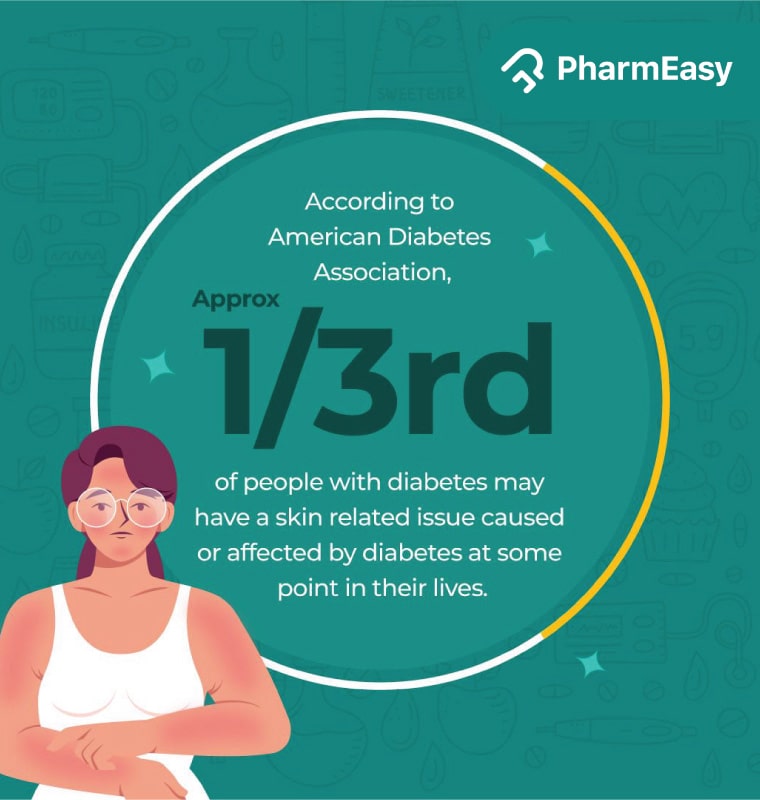Diabetic Skin Care: Everything You Need to Know
By PharmEasy Medical Board +2 more

Get,

to manage your symptom
Get your,


4 Cr+ families
benefitted

OTP sent to 9988776655



You’ve successfully subscribed to receive
doctor-approved tips on
Whatsapp

Get ready to feel your best.

Hi There,
Download the PharmEasy App now!!


Register to Avail the Offer
Send OTPBy continuing, you agree with our Privacy Policy and Terms and Conditions

Hi There,
Sign up on PharmEasy now!!
Trusted by 4 crore+ families

OTP sent to 9988776655



You have unlocked 25% off on medicines




Code: NU25
By PharmEasy Medical Board +2 more
Diabetes has the potential to impact not just the body, but every part of a patient’s skin. Hence, knowing about Skin Care & Diabetes is highly recommended. According to the American Diabetes Association, 1/3rd of people with diabetes will have a skin disorder caused or affected by diabetes at some point in their lives.

While most skin disorders can be prevented with care and medication, it is vital to catch the early signs and treat them immediately. It is a proven fact that most diabetic patients take a longer time to heal from injuries and thus, it is advisable for them to follow the ”prevention is better than cure” approach with their skin. Here’s all that you need to know about skincare & diabetes :

Dr Geetanjali Shetty is a Consultant Dermatologist and Cosmetologist with a specialization in Acne, Allergy Testing, Psoriasis and other Cosmetologically procedures. She currently heads the cosmetology clinic at Goregaon (West) Mumbai. Dr Shetty identifies some early triggers and symptoms such as prolonged rashes, ulcers, cut, blisters, skin infections or dryness in patients that serve as signs of the condition. Diabetes comes with a complex set of complications that can affect the skin. Having high levels of blood sugar or low levels of insulin can adversely impact the skin, making it more vulnerable to foreign object injuries.
Read on to understand how to take care of your skin if you have diabetes with expert dermatologist Dr Geetanjali Shetty.

Table of Contents
Even if you have not been diagnosed with diabetes yet, there are always some trigger points or symptoms that indicate the developing condition. People who have a strong family history of the disease are highly likely to develop it at some point in their lives. They may also occasionally suffer from skin changes or problems that do not go away easily, such as non-healing ulcers, blisters, continuous rashes in odd places, insect bites, minor irritation even after taking injections.
Following conditions are some of the early signs of diabetes in younger patients:
Acanthosis Nigricans is a result of hormonal changes in the form of pigmentation on the neck and parts of the necks. This condition manifests in the form of darkening and thickening of skin and results in velvety-patchy skin, especially around the neck and armpits. AN can be a sign of pre-diabetes, which increases the risk of getting diabetes at later stages. Making lifestyle changes before diabetes develops can prevent this condition from worsening.
This condition causes the skin on your toes, fingers and hands to become thick, waxy and tight. Tightening and stiffening of finger joints may also occur. Digital Sclerosis can be treated by maintaining low blood sugar levels in the body.
While the most common in type 2 diabetes, this condition results in the thickening of the skin on the neck and upper neck and can be controlled by bringing the blood sugar levels down in the body. Read more about the symptoms of type 2 diabetes.
A common condition resulting from bacterial and fungal infections is also an underlying symptom of diabetes. Repetitive boils and fungal infections accompanied by itchy and burning skin may develop. Keeping the skin dry and consulting a dermatologist can bring down folliculitis.
While some burns and fungal infections point towards underlined diabetes, neglected wounds and cuts in diabetes, patients may take a bad shape and can become ulcers if not treated immediately. These ulcers sometimes even turn into gangrenes, which can become life-threatening and need to be operated on. Non-healing ulcers, injuries, cuts, blisters, hair loss, repetitive vein infections, Acanthosis Nigricans, Digital Sclerosis, Prolonged fungal infections, which are also seen in pre-diabetes patients, are complex conditions that need to be addressed immediately.
Diabetes patients are extremely prone to skin problems and must maintain their blood sugar levels in an ideal condition. Keeping diabetes in check and getting sugar level tests done every 3-4 months is advisable. It is also important to understand when to see a doctor regarding your skin conditions.
It is recommended to consult a dermatologist:
Keeping the skin dry and clean is one of the predisposing conditions for diabetes patients and especially crucial for treating fungal infections. Skincare becomes complicated for diabetes patients and it is rudiment to understand what areas and body parts need special attention.
”Keep skin dry in areas where chances of developing a fungal infection are high, like groin and armpit and keep it moist in areas which come in contact with the immediate extreme environment like hands and legs.”
Legs, hands and nails can be identified as the most delicate areas in diabetes patients. Diabetic patients take longer to recover from any foreign object injuries and hence are advised to wear well-fitted shoes at all times. Body parts that come in immediate contact with the outside environment need to be moisturized and protected, especially nails and hands. Also, not addressing injuries immediately and delaying treatment may result in sores and deadly wounds. Skincare & diabetes are a crucial informative part of a diabetic patient’s life.
Following are some tips for intensive skin & foot care in diabetes patients:
Diabetes has the potential to dry out the skin and hence leave it more prone to injuries and infections. Dry and itchy skin is an open invitation to bacteria, which further complicates the skin by causing infections. Keeping the skin clean and dry is an extremely important ritual for diabetes patients. It is necessary to take care of your skin and identify which body parts need to be moisturized and which parts need to remain dry. Extra moisturizing can further lead to fungal allergies and infections and hence, diabetes patients are advised not to mix creams with oils and soap. Using organic and natural moisturizing agents is recommended. One of the most important takeaways for diabetes patients is taking enhanced care of their feet. Consulting podiatrists for diabetic foot care programs and customized orthotics are recommended to patients. Stay updated about skincare & diabetes.
Disclaimer: The information provided here is for educational/awareness purposes only and is not intended to be a substitute for medical treatment by a healthcare professional and should not be relied upon to diagnose or treat any medical condition. The reader should consult a registered medical practitioner to determine the appropriateness of the information and before consuming any medication. PharmEasy does not provide any guarantee or warranty (express or implied) regarding the accuracy, adequacy, completeness, legality, reliability or usefulness of the information; and disclaims any liability arising thereof.
Links and product recommendations in the information provided here are advertisements of third-party products available on the website. PharmEasy does not make any representation on the accuracy or suitability of such products/services. Advertisements do not influence the editorial decisions or content. The information in this blog is subject to change without notice. The authors and administrators reserve the right to modify, add, or remove content without notification. It is your responsibility to review this disclaimer regularly for any changes.

Leave your comment...
Comments